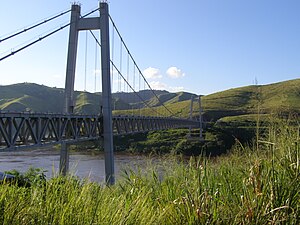Matadi Bridge
Matadi Bridge / OEBK Bridge | |
|---|---|
 | |
| Coordinates | 5°49′28″S 13°26′02″E / 5.824466°S 13.433865°E |
| Crosses | Congo River |
| Locale | Matadi |
| Characteristics | |
| Design | Suspension bridge |
| Total length | 722 metres (2,369 ft) |
| Longest span | 520 metres (1,710 ft) |
| History | |
| Construction start | 1979 |
| Opened | 1983 |
| Location | |
 | |
The Matadi Bridge, also known as the OEBK Bridge for Organisation pour l’équipement de Banana-Kinshasa, and formerly known as Pont Maréchal in French, is a suspension bridge across the Congo River at Matadi, Democratic Republic of the Congo. It was completed in 1983 by a consortium of Japanese companies. With a main span of 520 metres (1,710 ft), it was the longest suspension bridge in Africa from its inauguration until the 2018 opening of the Maputo–Katembe bridge.[1] The bridge crosses the Congo River at its narrowest point, just downstream from the port of Matadi. It is in fact the only bridge across the Congo River proper, some other bridges span the Lualaba River, a tributary of the Congo.
Construction
Matadi Bridge was completed in 1983 by a consortium of Japanese companies, led by Ishikawajima-Harima Heavy Industries.[2] It has a main span of 520 metres (1,710 ft) and crosses the Congo River.[3] Matadi Bridge was built with 14,000 tons of steel.[4] The bridge is designed in a way to emphasize that the towers are made up of bar members, with each tower being a single rigid frame.[5] 25 million[clarification needed] of the bridge was paid for by the Japanese government at the request of President Mobutu at a cost of 34.5 billion Japanese yen.[4] During war time the bridge was guarded and still remains as of 2016.[3]
Railway
A railway line across the bridge was intended to be part of a line to Boma and Muanda. However, it has never been in operation.[6]
See also
References
- ^ "Africa's longest suspension bridge opens to the public". 13 November 2018.
- ^ Morikawa, Jun (January 1997). Japan and Africa: Big Business and Diplomacy. C. Hurst & Co. Publishers. p. 138. ISBN 978-1-85065-141-3.
- ^ a b Shimomura, Yasutami; Page, John; Kato, Hiroshi (26 January 2016). Japan's Development Assistance: Foreign Aid and the Post-2015 Agenda. Palgrave Macmillan UK. pp. 48–. ISBN 978-1-137-50538-5.
- ^ a b Bernstein, Gail Lee; Fukui, Haruhiro (3 January 2016). Japan and the World: Essays on Japanese History and Politics. Palgrave Macmillan UK. p. 211. ISBN 978-1-349-08682-5.
- ^ Bridge Aesthetics Around the World. Transportation Research Board. 1991. p. 130. ISBN 978-0-309-05072-2.
- ^ Railway Gazette International September 2012, p. 42.
